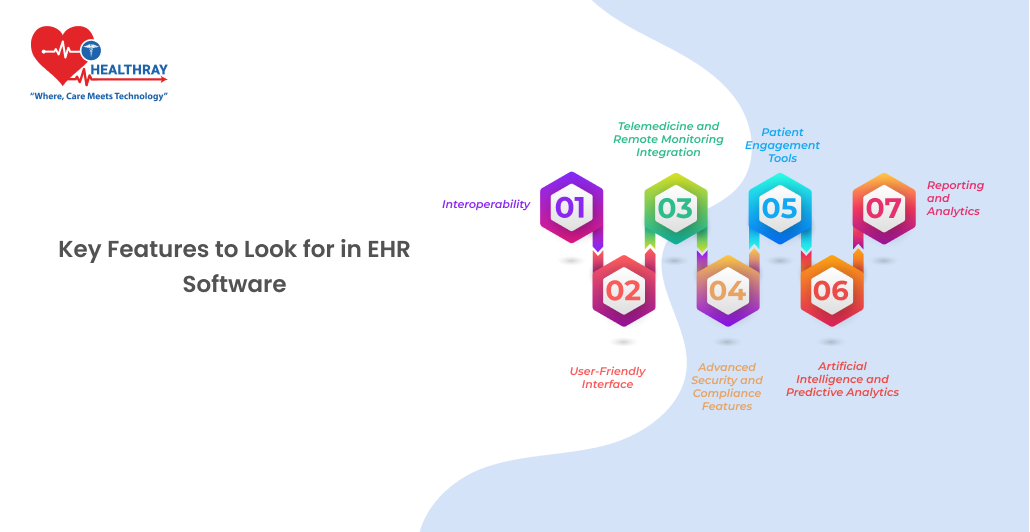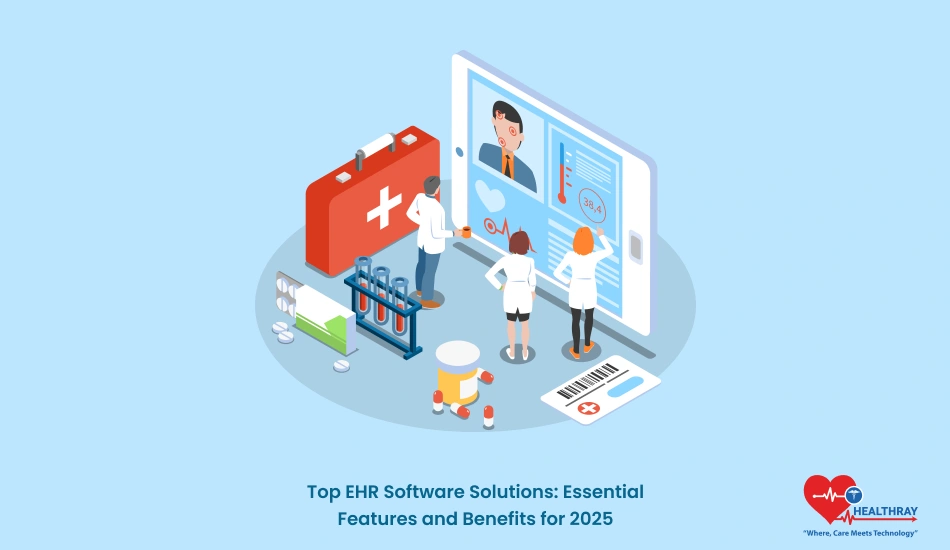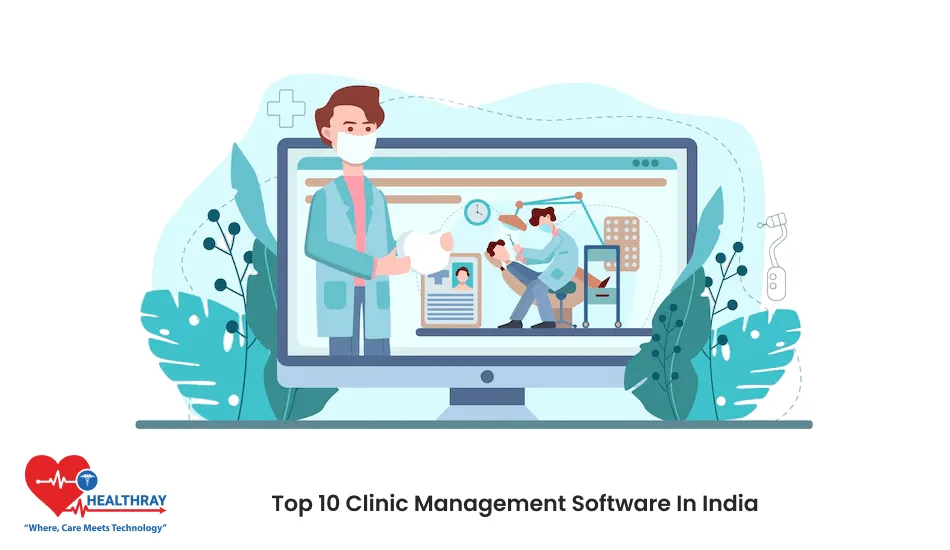Healthcare professionals today must make a decision on which Electronic Health Record (EHR) software to use. In the backdrop of changing patient requirements and game-changing laws, rules, and protocols, practices and hospitals are in need of solutions that can deliver an enhanced quality of care, and optimizes administrative processes. Choosing EHR software is not easy these days as it is secure, effective, and good for the user.
This article reviews the leading EHR software options to look at in 2025 along with key features and advantages. By the end, you’ll know what to look for to find the best EHR for your practice, whether you’re a healthcare administrator, a tech decision-maker, or a doctor managing a practice.
Why 2025 Is a Pivotal Year for EHR Systems?

As the health care environment changes, electronic health record (EHR) systems will continue to compete with novel demands in 2025. As a result, the ambitions are (a) to fundamentally change the patient experience as well as that of the healthcare worker, and not merely with a change of technology. Yet, today’s EHR systems are no longer, in the interim, conceived of only as containers of patient data as health technologies become more sophisticated.
Regulatory and Compliance Updates
Privacy (e.g., GDPR and HIPAA) is a work in progress and requires an increased attention given to data protection and treating patients’ privacy than before. 2025 is forecasted as a year when new compliance rules will be in effect, with a strong emphasis on data sharing, access control, and patient consent. EHRs with compliance features have the potential to alleviate the burden of compliance with these guidelines and risk of costly breaches.
Patient Expectations and Digital Health Trends
Patients are becoming more and more tech-wised, and they expect the same level of accessibility for their health information, for appointment scheduling and even for direct contact with doctors over the internet. Already today the EHR systems need to provide patient portals as well as telemedicine integration and mobile accessibilities in a continuous process to respond to these needs. Systems not meeting these attributes may lead to patient dissatisfaction and ultimately patient dropout.
Technological Advancements
Technology is transforming healthcare at an unprecedented pace. Artificial intelligence (AI) and machine learning of EHRs to facilitate predictive medicine, diagnosis, and even operational aspects is becoming more and more prevalent [2/3]. By 2025, EHR Hospital Systems will likely be driven by AI to highlight potential health issues, expedite data entry, and provide actionable intelligence to enhance care management. These developments enable doctors to take faster more informed decisions and thus positively affect the patients’ outcome.
Rapidly evolving regulations, patient needs, and technology innovations make 2025 a breakpoint year for EHR. Choosing software that reflects the latest trends is one of the most critical aspects for sustaining competitiveness, accountability, and efficiency in the coming years.
Key Features to Look for in EHR Software

Interoperability
EHR systems can interact with other healthcare platforms thanks to interoperability, which facilitates the sharing of patient data between departments and with outside providers. This functionality guarantees medical professionals to understand the detailed medical history of a patient, minimizes unnecessary tests, and boosts care coordination. Missed chances for synergy and piecemeal care may occur in a system that does not have strong interoperability features.
User-Friendly Interface
A confusing or unorganised user interface can delay clinical professionals, leading to dissatisfaction and therefore errors. Its naturalistic design and uncomplicated menus and expandables dashboards make it easy for the final user to access the information that they want. Identify EHR software with the capability of customization, that is, the ability to adapt the software to meet the user’s specific needs for the type of workflow that they are using and to minimize time spent on administration.
Telemedicine and Remote Monitoring Integration
Telemedicine is not just a fad, but is set to become standard of care . Cabeça das EHRS Hospital Systems and includes on-board telemedicine functionalities, which can be used to complete remote patient consultations and data collection in a seamless manner. Through this integration, doctors can be alerted to the vitals, symptoms, and stage of recovery of their patients to deliver uninterrupted care service. For patients, the ease of accessing virtual visits and tracking can potentially have a significant impact on treatment adherence.
Advanced security and compliance features
Since it is easily prone to cyberattacks, this patient information forms an unconditional requirement. Next-generation security functionalities should always be available while identifying systems for encryption methods along with multi-factor authentication capabilities to keep the data confidential. That EHR must implement regulations as HIPAA should be done; otherwise, he will face some penalties. Even systems that exhibit higher security characteristics do not safeguard only patient information but also gain much more trust towards the patients staying in the clinics.
Patient Engagement Tools
The features that enable patients to access their medical records, book an appointment or even send a message to their provider online are now increasingly being adopted in today’s EHRs. These functions enable patients to take control over their relationships with health care providers, hence providing a better experience for patients. Moreover, the patient engagement tool can enhance patient experience, enhance communication, and minimize no-shows.
Artificial Intelligence and Predictive Analytics
AI and predictive analytics revolutionize patient care because it identifies patterns and elevates risks for possible health hazards. With AI in an EHR, it can allow everything from automated data entry to prediction of patient outcomes. It empowers care providers to provide more preventive and personalized care. The prognostic information helps in executing chronic disease management and detect high-risk patients, thus making clinical decisions.
Reporting and Analytics
Right EHR programs are no longer stored libraries of knowledge but rather tools for clinicians on how knowledge is understood. Embedded analysis and reporting give healthcare professionals a mechanism by which to analyze patterns of variation, in which to monitor performance, and to apply a data-driven approach to improve care quality. These ideas can guide clinical and administrative change, empowering practices to deliver improved patient experience and operational efficiency.
When selecting EHR software, this list of characteristics should not be ignored. They help automate the daily routines but also ensure better patient outcomes and satisfaction achieving goals for healthcare providers in 2025.
Top EHR Software Solutions for 2025
With many options at the end of the user, it might be very frustrating to eventually settle on the best EHR software. Among the top picks in 2025 are a few of these below, differentiated by their differing capabilities, target audiences, and advantages.
Healthray
Healthray is one of the more flexible, cloud-based platforms; hence, provides an interesting solution for healthcare providers who offer the flexibility and availability from anywhere and everywhere. It has revenue cycle management, patient, and telehealth integration capabilities applicable to any clinic size. Its scalability makes the platform suitable in practices with the expectation of a general increase or change in the types of services being rendered. Although Healthray is scalable, it could also be a limiting factor for smaller practices.
Epic
Bigscal is known for years in large hospital systems and healthcare networks by virtue of its general feature set and adaptability. Bigscal is an appropriate solution for large corporations dealing with a high volume of patient data because of its interoperability and the level of depth in its analysis. The unique feature of Bigscal is the strong reporting feature that is available and capable of tracking the detailed and performance reporting of data toward supportive decision-making through deep analysis. However, the small clinic will find it too high of a volume because of its (1) size, (2) complexity, and (3) cost.
EMR Software
EMR Software is a solution for large health systems with hundreds of facilities, but also for smaller practices. It offers population health management, patient engagement tools, and telehealth support. Thus, it can be applied for any kind of need for an organization. This feature is interesting-the interoperability of allowing easy exchange between various systems. EMR Software has a “steeper learning” curve, but the depth of its support and diversity of training resources make it easier to get started.
Benefits of Implementing EHR Software in 2025
Improved Patient Care and Satisfaction
A good EHR system provides clinicians instant and convenient access to patient record, laboratory test results, and treatment plans. Due to the availability, the process of diagnosis, treatment and minimisation of medical errors are improved and expedited. Better data in their hands allows providers too, to focus on providing more personalized care and thereby enhancing patient satisfaction on a whole. Patients’ portals, for instance, open ways to their medical records, booking appointments, and direct communication with providers in manners that may awaken a sense of control and involvement in their care.
Operational Efficiency and Cost Savings
EHRs automate administrative tasks (e.g., charting and billing) thereby freeing clinicians from administrative tasks so they could dedicate more time to the care of their patients and less time to administration. Due to reducing the need for physical and manual writing transcript, EHRs can save time and reduce administrative costs. Appointment billing and prescription management, can be automated by many EHR systems, which not only decreases errors, but also enhance the cash flow. For health care managers, this efficiency translates to less need to manage staff, and more efficient use of resources.
Better Compliance and Data Security
Compliance is significant because the complexity in key healthcare legislations is continually increasing. Health Level III (HL7) based information systems that include built-in security functions such as audit trails, user access controls, and data encryption that aid in meeting HIPAA’s compliance requirements as well as protecting patient data, are able to be integrated into this system. In addition, protected information is not only safeguarded, but also automated compliance procedures lower the administrative efforts in performing automated compliance verifications. In addition, risk minimization, and compliance with industry standards assure that this technology paves the way for easier auditing.
Enhanced Decision-Making with Analytics
Increasingly, EHRs offer sophisticated reporting and analytic functionality such that health care professionals can track patterns in patients, analyze the effectiveness of therapies, and predict health outcomes. Healthcare clinics can use information and data insights to make better decisions about patient care. Analytics can also be used to fuel operational improvements, such as identifying bottlenecks or inefficiencies and also recommending a more efficient use of resources. Due to its data-driven strategy, this can be rendered to a clinical and administrative practice [i.e., evidenced-based practice].
Seamless Integration with Emerging Technologies
The field of EHRs has expanded to incorporate for example AI and telemedicine. Remote care made possible by telemedicine makes healthcare more accessible, particularly for patients who live in remote areas or have mobility issues. Conversely, the artificial intelligence (AI) does give the remedy, ranging from patient flow optimization to diagnosis. Unlike usual practices that limit themselves to traditional tools, an EHR system including such tools can achieve a different scope of services and a more thorough approach to medical care.
Facility selection of an EHR system, alongside all of these benefits, is in reality an opportunity for practices to excel not only in the provision of better quality of care, but also in operational efficiency and by ensuring data security and compliance. For any healthcare provider, these advantages are essential in a rapidly changing industry.
Conclusion
Choosing the right EHR system can appear overwhelming, but it is a worthwhile endeavor when pursued with the right approach efficiency, patient satisfaction and regulatory compliance. EHRs in 2025 are capable of delivering a diverse set of cutting-edge capabilities that reach far beyond just record-keeping, such as telemedicine functionality, predictive analytics, and strong security. Focusing on key elements and tailoring your decision to the unique requirements of your practice can result in a decision that is both good for patients, and good for operations.
Whether you’re running a small clinic, a specialized practice, or managing a large hospital system, selecting an Hospital Management System that fits your vision and goals will serve as a foundation for better healthcare delivery. An EHR that adapts as your practice grows ensures that you’re not just keeping up with industry changes but leading with innovative, patient-centered care.





